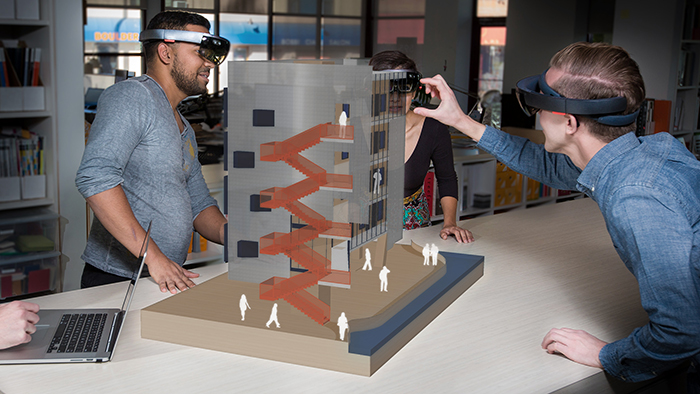Mixed reality application allows users to inhabit and experience designs
Trimble has launched its SketchUp Viewer for Microsoft HoloLens, a new mixed-reality solution that lets users virtually inhabit and experience their designs.
Launched today at Trimble Dimensions, Trimble, Microsoft and architect Greg Lynn demonstrated how the SketchUp Viewer solution could be used to help improve design and construction processes.
Using HoloLens, architects were able to experience SketchUp models in mixed reality, as holograms placed in the real world — enabling them to quickly analyze various “what if” design scenarios in the context of the physical environment. The demonstration also illustrated how using Trimble solutions with HoloLens holographic technology enables remote teams to effectively review and collaborate in order to resolve constructability issues in real time.
Greg Lynn used Trimble’s mixed-reality solution and Microsoft HoloLens to re-imagine the Packard Plant — a historic, abandoned automobile factory in Detroit. The architectural project was commissioned as part of the US Pavilion at the 2016 Venice Biennale exhibition in Italy.
“Trimble mixed-reality technology and Microsoft HoloLens bring the design to life and bridge the gap between the digital and physical. Using this technology I can make decisions at the moment of inception, shorten the design cycle and improve communication with my clients,” said Greg Lynn.
With SketchUp Viewer, users can view models that have been published to their HoloLens device via the newly launched AR|VR Extension for SketchUp Desktop; they can browse and download models from Trimble’s 3D Warehouse or they can pull project files down from Trimble Connect, a cloud-based collaboration platform. Users then have the option to place a model within their physical environment.
In Tabletop mode, models can be scaled as needed to best fit the available space or specific design review requirements. While the experience is intended to mimic viewing a physical scale model, it maintains the flexibility and the dynamic nature of a digital model. Users can re-scale, move and rotate the model as desired. Models can be anchored and re-anchored in the physical environment, so designers and engineers can walk around the project and examine it from any vantage point.
In immersive mode users can immerse themselves in a project at its true scale for the best possible experience of what a design will really feel like.
In both Tabletop and Immersive mode, SketchUp Viewer allows users to do more than just look at the model. The application provides access to the most critical pieces of information for making vital project decisions and gaining consensus among project stakeholders. The Entity Info feature gives users access to important Building Information Modeling (BIM) data embedded within project components; and with the Tape Measure functionality, users can pull up dimensional information from the model. Users can also control the visibility of various aspects of the model by toggling layers on and off.
Real-time, remote and co-located collaboration are key elements to the experiential design review process in SketchUp Viewer. With multiple HoloLens devices, a group of users can load the same model, engaging a “see what I see” collaboration mode. Remote collaborators can communicate via real-time audio and use mixed-reality visualization “sight-guides” to better understand who in the group is looking at what.
SketchUp Viewer for Microsoft HoloLens is available now from the Microsoft Windows Store.
A new AR|VR extension for SketchUp Desktop, which enables users to publish models directly from their desktop to the Microsoft HoloLens, is available from SketchUp’s Extension Warehouse. Microsoft HoloLens devices are available for purchase from the Microsoft Store:
If you enjoyed this article, subscribe to AEC Magazine for FREE






